Bridgnorth
Bridgnorth is a town in Shropshire, England. The River Severn splits it into a High Town and Low Town, the upper town on the right bank and the lower on the left bank of the River Severn. The population at the 2011 Census was 12,079.
| Bridgnorth | |
|---|---|
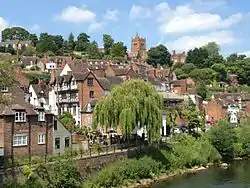 High Town from the River Severn | |
 Coat of arms of Bridgnorth Motto: Fidelitas Urbis Salus Regis In the town’s loyalty lies the King’s safety [1] | |
 Bridgnorth Location within Shropshire | |
| Population | 12,079 (2011)[2] |
| OS grid reference | SO716927 |
| Civil parish |
|
| Unitary authority | |
| Ceremonial county | |
| Region | |
| Country | England |
| Sovereign state | United Kingdom |
| Post town | BRIDGNORTH |
| Postcode district | WV15, WV16 |
| Dialling code | 01746 |
| Police | West Mercia |
| Fire | Shropshire |
| Ambulance | West Midlands |
| UK Parliament | |
History

Bridgnorth is named after a bridge over the River Severn, which was built further north than an earlier bridge at Quatford.[4] The earliest historical reference to the town is in 895, when it is recorded that the Danes created a camp at Cwatbridge;[5] subsequently in 912, Æthelfleda constructed a mound on the west bank of the River Severn, or possibly on the site of Bridgnorth Castle, as part of an offensive against the Danes.[4][6] Earliest names for Bridgnorth include Brigge, Brug and Bruges, all referring to its position on the Severn.[7]
After the Norman conquest, William I granted the manor of Bridgnorth to Roger de Montgomerie.[6] The town itself was not created until 1101, when Robert of Bellême, 3rd Earl of Shrewsbury, the son of Roger de Montgomerie, moved from Quatford, constructing a castle and a church on the site of the modern-day town. The town became a royal borough on Robert Bellême's attainder in 1102.[6] The castle's purpose was to defend against attacks from Wales.[4] The town was attacked and burnt by Roger Mortimer, 1st Earl of March during the Despenser War in 1322.[8]
Bridgnorth's town walls were initially constructed in timber between 1216 and 1223; murage grants allowed them to be upgraded to stone between the 13th and 15th centuries.[9] By the 16th century, the antiquarian John Leland reported them in ruins and of the five gates, only one survives today.

It is probable that Henry I granted the burgesses certain privileges, for Henry II confirmed to them all the franchises and customs which they had had in the time of Henry I.[10] King John in 1215 granted them freedom from toll throughout England except the city of London, and in 1227 Henry III conferred several new rights and liberties, among which were a gild merchant with a hanse. These early charters were confirmed by several succeeding kings, Henry VI granting in addition Assize of Bread and Ale and other privileges. The burgesses were additionally granted two fairs: a yearly fair on the feast of the Translation of St Leonard and the three following days was granted in 1359, and in 1630 Charles I granted them licence to hold another fair on the Thursday before the first week in Lent and two following days. The burgesses returned two members to parliament in 1295,[11] and continued to do so until 1867, when they were assigned only one member. The town was disfranchised in 1885.[6]
During the Civil War, Bridgnorth was one of the Midlands' main royalist strongholds, and in 1642 many royalist troops were garrisoned there. In 1646, Cromwell's Roundheads arrived with orders to take Bridgnorth for the Parliamentarians from the garrison led by Sir Robert Howard. After a three-week siege, Cromwell was successful and he ordered that the castle be demolished.
By 1824, the borough and liberties of Bridgnorth were well defined.[12]
The population of the municipal borough in 1841 was 6,198, and that of the town was 5,770.[13]
More than 255 men from the Bridgnorth area volunteered in the first months of the First World War. Their names were published in the Bridgnorth Journal on 26 December 1914 and several of those killed in action are remembered on the war memorial in the castle grounds.
Until 1961 the Royal Air Force's initial recruit training unit was at RAF Bridgnorth, a station opened in 1939. During the Second World War, two women were killed in a German air raid in August 1940 when bombs hit neighbouring houses in High Town. In 2005, unverified German papers dating from 1941 were found, outlining new details about Operation Sea Lion, the military plans of Nazi Germany for an invasion of Britain. Two quiet Shropshire towns were mentioned in the documentation: Ludlow and Bridgnorth. Some experts believe that it was Hitler's intention to make Bridgnorth his personal headquarters in Britain, due to its central position in the UK, rural location rail connections and airfield.[14][15]
In 1978, Bridgnorth twinned itself with the French town of Thiers, and in 1992 it also twinned with the Bavarian town of Schrobenhausen, Germany[16] that had already twinned with Thiers a few years earlier. On 21 August 2003 Bridgnorth was granted Fairtrade Town status.[17]
Landmarks
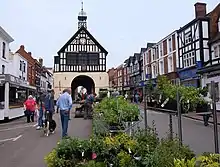
Bridgnorth is home to a funicular railway that links the high and low towns, the Castle Hill Railway, which is the steepest[5] and only inland railway of its type in England.[18] Additionally, within the High Town is Bridgnorth railway station on the Severn Valley Railway, which runs southwards to Kidderminster. The ruins of Bridgnorth Castle, built in 1101, are present in the town. Due to damage caused during the English Civil War, the castle is inclined at an angle of 15 degrees.[19]
High Town is dominated by two Church of England churches. Church of St. Mary Magdalene, Bridgnorth, a church built in the classic style of the late 18th century,[6] was designed by Thomas Telford;[20] and is still used for worship. St. Leonard's was formerly collegiate, and Bridgnorth was a Royal Peculiar until 1856. It was subsequently largely rebuilt[21] but is no longer used for regular worship. It has many community uses and is in the care of the Churches Conservation Trust.
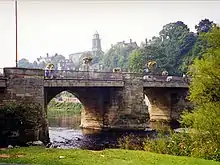
Bishop Percy's House on the Cartway was built in 1580 by Richard Forster and has been a Grade 1 listed building since 18 July 1949. It was one of the few properties of its type to survive the great fire of Bridgnorth in April 1646, and was the birthplace of Thomas Percy (Bishop of Dromore), author of ‘Reliques of Ancient English Poetry’.[6][22][23]
Other notable buildings in the town are the 17th century Bridgnorth Town Hall, a half-timbered building,[24] and a surviving town gate the Northgate which houses the museum.[25] Daniel's Mill, a well known watermill is situated a short distance along the River Severn from Bridgnorth.
The remains an old hermitage can be seen from the high town, they are commonly called The Queens Parlor by locals. One local legend tells of its occupation in AD 925 by a hermit called Ethelred or Ethelwald, a grandson to Alfred the Great. This may not be such an unlikely story as Bridgnorth was founded in 912 by Alfred the Greats Daughter Ethelfleda.
Education

There are a number of Primary Schools in Bridgnorth, including: Castlefields County Primary School, two Church of England schools, St Mary's and St Leonard's; the Roman Catholic St John's school; and, in addition, the Morville and Brown Clee schools.[26]
The town has two Secondary schools: Oldbury Wells School and Bridgnorth Endowed School (previously named Bridgnorth Grammar School).[26] These serve the town and its outlying villages, including Alveley and Highley.
For many years there was a Bridgnorth College, however this was demolished to make way for a new housing estate in the mid-2000s.
Culture
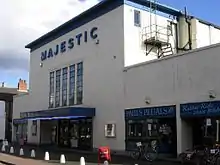
There is a theatre, the Theatre on the Steps, and a 1930s cinema, the Majestic. The Northgate Museum contains many artifacts connected with the town and surrounding area. It was the first independent museum in Shropshire to be accredited by the Museums, Libraries and Archives Council.[27] The town has a number of bars and restaurants and, beyond these, there are 27 pubs.
Sport and clubs

Bridgnorth Town F.C. was the football club based in Bridgnorth. They joined the Worcestershire Combination in 1938 and twice reached the 5th round of the FA Vase. They won the championship of the West Midlands (Regional) League Premier Division in 2008. Affiliated to the club was the junior section known as "Bridgnorth Town Juniors". The teams ranged from under 8s to under 16s and competed in the Telford Junior League. After folding, the club was effectively replaced by "phoenix club" A.F.C. Bridgnorth. Bridgnorth Spartans Juniors Football Club run junior and adult teams. These teams include boys' teams, ranging from Under-8s to Under-15s, girls' teams and women's teams. Home games are played at Oldbury Wells School.
Bridgnorth Rowing Club hosted a competition between Shrewsbury School and Cheltenham College in 1865. It currently occupies 'The Maltings' building on the edge of Severn Park, which was purchased by the club in 1983. Work to convert the malting building into the boat house started in 1993. The boathouse now consists of a ground floor area with racking spaces for singles, doubles, fours and eight man boats. There is also a raised area and mezzanine platform that houses the indoor rowing machines (ergometers) and weights gym. Upstairs there are changing rooms and a club room with a bar and a balcony overlooking the River Severn. Bridgnorth Rowing Club regularly competes in events in the local region and further afield, including attending the annual Head of the River Race on the Thames in London. Bridgnorth Rowing Club hosts an annual regatta inviting clubs from all over the country. It also hosts an annual 'fun regatta' event which is open to members of the local community and businesses to enter and compete; in which all competitors are trained up for a main day of racing. Racing takes part along the length of the Severn Park.

Bridgnorth Army Cadets is the oldest Army Cadet detachment in Shropshire. The Army Cadet Force (ACF) in 2010 celebrated 150 years.
Bridgnorth has a table tennis club. Bridgnorth have represented Shropshire in the ETTA`S Wilmott cup
In 2007, Bridgnorth hosted the UK Downhill Street Race in cycling.
In January 2010, the Kidderminster branch of Stagecoach Theatre Arts expanded to Bridgnorth, providing the town with a part-time performing arts school for people of ages between 6 and 18. The Kidderminster School is now named "Stagecoach Kidderminster & Bridgnorth".
Bridgnorth has a cheerleading team, established in 2001, the Bridgnorth Tigers Cheerleading Club. The BTCC hold the title of national small senior team champions for 2003.
Transport

Bridgnorth grew initially as a market town at the centre of a system of local radial roads linking it with more rural, smaller settlements. Many of these roads crossed Bridgnorth at the point on the High Street where the town hall now stands. Bridgnorth is connected to Shrewsbury by the A458 road, to Telford by the A442 road and Wolverhampton via the A454 road.

Bridgnorth has a bypass road, construction of which was started in 1982, and which now serves to relieve the town centre of the congestion it was once plagued by.
The town is 9 miles (14 km) from the M54 and 16 miles (26 km) from the M6 motorways.
Buses
The town is served by buses to and from Telford, Shrewsbury, Wolverhampton, Much Wenlock, Ironbridge, Shifnal, Kidderminster and Stourbridge. These are operated by Arriva Midlands and Diamond Bus.
Rail

Currently the closest towns with active railway stations on the National Rail network are Telford and Wolverhampton. However, Bridgnorth does still have a station on an active heritage line, the Severn Valley Railway. Bridgnorth station was not the northern terminus of this line when built, but the main intermediate station, being 18¼ miles from Hartlebury and 22½ miles from Shrewsbury. The station was opened to the public by the SVR on 1 February 1862, was passed to Great Western Railway (GWR), and then eventually to British Railways in 1948. It closed to passengers after 101 years of service on 8 September 1963, and to freight traffic on 30 November 1963. Although thought by some to have been closed as part of the Beeching cuts its planned closure pre-dated his report.
The neo-Jacobean station is the only listed railway station on the Severn Valley Railway. Necessitating that any future plans to enhance visitor facilities will need to be carefully designed to be in keeping with the railway station's architecture and historic character.
The line now ends just north of the modern-day station, where the line formerly bridged Hollybush Road and passed through Bridgnorth Tunnel and on to the next station on the line, Linley. There exists an ongoing debate whether the railway should extend beyond its current limits north of Bridgnorth.[28]
Cliff railway

The Bridgnorth Cliff Railway (also known as the Bridgnorth Funicular Railway or Castle Hill Railway), is a funicular railway which has operated in Bridgnorth for over 100 years. The line links the lower part of High Town to the upper part. The bottom entrance is adjacent to the River Severn while the top is adjacent to the ruins of Bridgnorth Castle.
Opened on 7 July 1892 to great fanfare and the proclamation of a public holiday, the line is one of four funicular railways in the UK built to the same basic design (the others were the Clifton Rocks Railway in Bristol; the Lynton and Lynmouth Cliff Railway in Devon; and the Constitution Hill Railway in Aberystwyth, Wales). It is one of the steepest railways in the country, and at least one source (the information panel outside the top station) claims it is both the steepest and shortest. It is the only functional inland funicular railway in England (there are about 15 more at English seaside towns).[29] Originally the railway was powered by a simple system using water and gravity, but were converted in 1943–44 to run on electricity. Then in 1955 new cars were installed on the railway; able to carry 18 passengers each, these cars are still in use today. As of 2019; a return ticket is offered at £1.60. Single tickets are not offered for purchase.
The railway allows people to easily get between the two parts of High Town as the only other way down is down ≈200 steps or by using roads which drastically increase the journey. The terminals at the upper and lower part of the railway are currently used as tea-rooms and guest houses.
Walking and cycling
Bridgnorth is on National Route 45 of the Sustrans National Cycle Network, which is named the Mercian Way.
There is a great deal of good walking country around Bridgnorth, which is located close to the Shropshire Hills Area of Outstanding National Beauty.
Every year since 1967 a sponsored walk has been held in Bridgnorth.[30] Since 2017 this has been organised by the Bridgnorth Lions Club.[30]
Notable Townsfolk
Active up to 1900

- Richard Baxter (1615–1691) English puritan divine,[31] called by Dean Stanley “the chief of English Protestant Schoolmen”
- Francis Moore (1657–1715), physician and astrologer, originator of Old Moore's Almanack.[32]
- Elizabeth Jeffries (1727–1752) was an English woman [33] executed for murder
- Thomas Percy (1729–1811) was Bishop of Dromore,[34] County Down, Ireland
- William Macmichael (1783–1839) physician and medical biographer,[35] author of The Gold-Headed Cane (1827)
- Samuel Bache (1804–1876) was an English Unitarian minister [36]
Active after 1900
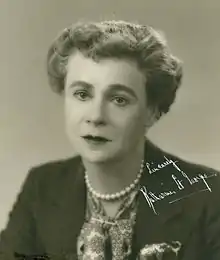

- Sir Terence O'Connor KC, MP (1891–1940) a Conservative Party politician, MP for Luton 1924/1929 and Nottingham Central 1930/1940 and Solicitor General 1936/1940
- John Dudley North (1893–1968), CBE, HonFRAeS, MIMechE, was Chairman and Managing Director of Boulton Paul Aircraft
- Katharine St. George (1894 in Bridgnorth–1983) was [37] a Republican member of the US House of Representatives and cousin of President Franklin Delano Roosevelt.
- Thomas Orde Lawder Wilkinson VC (1894–1916) Canadian and British Army officer,[38] posthumously awarded the Victoria Cross
- Elizabeth Dilys Powell, CBE (1901–1995) journalist [39] who wrote for The Sunday Times for over fifty years, best known as a film critic.
- Air Commodore Cathcart Wight-Boycott CBE DSO and bar MA (1910–1998) fighter pilot [40] during WW2 and then a senior RAF officer.
- Ross Antony (born 1974) musical actor,[41] singer, TV entertainer in Germany.
- Peter Bullock (1937–2008) soil scientist,[42] worked on soil morphology and land degradation.
- George Helon (born 1965) Freeman of the City of London, author, businessman and historian.
- Dominic Sandbrook (born 1974) historian, author,[43] columnist and TV presenter.
Sport

- Trevor Meredith (born 1936) footballer, 270 pro appearances, mainly for Shrewsbury Town.
- Ken Armstrong (born 1959) former footballer, about 170 pro appearances, injured, became NHS manager in Tayside.[44]
- David Preece (1963–2007), midfield footballer,[45] played three times for the England B team.[46]
- Craig Parnham (born 1973) field hockey defender and coach,[47] represented GB in the 2000 & 2004 Summer Olympics.
- Ashley Westwood (born 1976) former footballer [48] and football manager; made over 400 pro appearances mainly for Crewe Alex, Sheffield Wednesday F.C. and Wrexham F.C.
Old Bridgnorth School
Twin towns
Closest cities, towns and villages
See also
References
- "Civic Heraldry Of England And Wales-Severn Valley And The Marches". Civicheraldry.co.uk. Archived from the original on 4 May 2012. Retrieved 29 May 2013.
- "Bridgnorth (Parish): Key Figures for 2011 Census". Neighbourhood Statistics. Office for National Statistics. Archived from the original on 4 March 2016. Retrieved 23 November 2015.
- "Bridgnorth Town Council". Retrieved 10 April 2019.
- Raven, Michael (2005). A Guide to Shropshire. Michael Raven. p. 32. ISBN 0-906114-34-9. Retrieved 14 May 2008.
- "Bridgnorth". Shropshire Routes to Roots. Archived from the original on 8 September 2008. Retrieved 14 May 2008.
-
 One or more of the preceding sentences incorporates text from a publication now in the public domain: Chisholm, Hugh, ed. (1911). "Bridgnorth". Encyclopædia Britannica. 4 (11th ed.). Cambridge University Press. pp. 559–560.
One or more of the preceding sentences incorporates text from a publication now in the public domain: Chisholm, Hugh, ed. (1911). "Bridgnorth". Encyclopædia Britannica. 4 (11th ed.). Cambridge University Press. pp. 559–560. - "Bridgnorth, Shropshire". The National Gazetteer of Great Britain and Ireland 1868 transcribed by Colin Hinson ©2012. GENUKI UK and Ireland Genealogy. Retrieved 27 June 2013.
- Parliamentary Writs Alphabetical Digest, II, London: National Archives, 1834
- "Fragment of Town Walls (listed section), rear of 93 Cartway (E and N side), SMRNO00374". Discovering Shrophshire's History. Retrieved 22 October 2011.
- "BRIDGNORTH, Shropshire – Extract from National Gazetteer, 1868". GENUKI. Archived from the original on 27 January 2006. Retrieved 14 May 2008.
- "Parliamentary Constituencies in the unreformed House". Retrieved 14 May 2008.
- Shropshire gazetteer (1824). The Shropshire gazetteer. p. 862. Retrieved 10 June 2020.
- The National Cyclopaedia of Useful Knowledge, Vol III, (1847), London, Charles Knight, p.804
- "Hitler's secret Shropshire plans". BBC. 19 April 2005. Retrieved 2 January 2010.. The airfield was mentioned in 2005 by an auctioneer's consultant, unaware that nearby RAF Bridgnorth, created in 1939 as a recruit training depot, never had an airfield; but German war planners might have assumed all major RAF depots had airfields.
- Richie Woodall (presenter) (10 December 2012). Adolf Hitler's plans for British base in Shropshire. BBC Inside Out. Retrieved 10 December 2012.
- "Twin Towns". Bridgnorth District Council. Archived from the original on 21 November 2008. Retrieved 14 May 2008.
- "History Of Bridgnorth, Shropshire". About Bridgnorth. Archived from the original on 30 April 2008. Retrieved 14 May 2008.
- "Bridgnorth Town Guide". BBC Shropshire. Retrieved 14 May 2008.
- "Bridgnorth Castle". Visit Britain. Retrieved 14 May 2008.
- "St Mary Magdalene, Bridgnorth". Engineering Timelines. Archived from the original on 10 November 2006. Retrieved 14 May 2008.
- Newman, John; Pevsner, Nikolaus (2006). Shropshire. Yale University Press. p. 161. ISBN 0-300-12083-4. Retrieved 14 May 2008.
- "Bishop Percys House, bridgnorth". Archived from the original on 7 September 2011. Retrieved 16 April 2011.
- "Bishop Percys House". Bridgnorth Tourist Information Guide & Business Directory. Retrieved 19 October 2015.
- Historic England. "Town Hall (1053998)". National Heritage List for England. Retrieved 23 December 2020.
- Historic England. "North Gate (1374846)". National Heritage List for England. Retrieved 23 December 2020.
- "Shropshire County Council maintained schools in Bridgnorth". Shropshire County Council. Retrieved 2 July 2008.
- "Bridgnorth's Northgate Museum". Bridgnorthmuseum.org.uk. 1 November 2007. Retrieved 29 July 2015.
- "SVR-Online Forum :: View topic – North of B'north". Forum.svra.org.uk. Archived from the original on 12 May 2014. Retrieved 29 May 2013.
- "Bridgnorth Cliff Railway put up for sale". BCC News. 2 March 2011. Retrieved 2 March 2011.
- "The Bridgnorth Walk and Marathon". Bridgnorth Lions. Retrieved 22 January 2012.
- Chisholm, Hugh, ed. (1911). . Encyclopædia Britannica. 3 (11th ed.). Cambridge University Press. pp. 551–552.
- West Midlands Literary Heritage: Bridgnorth Archived 11 May 2008 at the Wayback Machine
- Exclassics.com website, ELIZABETH JEFFRIES AND JOHN SWAN retrieved December 2017
- Dictionary of National Biography, 1885-1900, Volume 44, Percy, Thomas (1729-1811) retrieved December 2017
- Royal College of Physicians, MACMICHAEL, William (1783–1839) retrieved December 2017
- Dictionary of National Biography, 1885-1900, Volume 02, Bache, Samuel retrieved December 2017
- Biographical Directory of the United States Congress, Katharine St. George (id: S000764) retrieved December 2017
- The London Gazette, Publication date:26 September 1916, Supplement:29765, Page:9418 retrieved December 2017
- The Independent, 4 June 1995, OBITUARY:Dilys Powell retrieved December 2017
- Air of Authority, A History of RAF Organisation retrieved December 2017
- IMDb Database retrieved December 2017
- The Guardian, 1 Jul 2008, OBITUARY:Peter Bullock retrieved December 2017
- IMDb Database retrieved December 2017
- "Ninewells Hospital staff furious over NHS Tayside probe into missing cash". The Courier. Dundee. 7 August 2012. Retrieved 29 December 2017.
- SoccerBase Database retrieved December 2017
- "David Preece". Luton Town. Archived from the original on 18 April 2009. Retrieved 14 May 2008.
- Craig Parnham, School of Sport, Performing Arts and Leisure, University of Wolverhampton retrieved December 2017
- SoccerBase Database retrieved December 2017
- Bridgnorth Town Council website retrieved 19 January 2019
- BRIDGNORTH & DISTRICT TWINNING ASSOCIATION retrieved 21 January 2019
- "National Commission for Decentralised cooperation". Délégation pour l’Action Extérieure des Collectivités Territoriales (Ministère des Affaires étrangères) (in French). Archived from the original on 4 October 2013. Retrieved 26 December 2013.
External links
| Wikimedia Commons has media related to Bridgnorth. |
| Wikivoyage has a travel guide for Bridgnorth. |